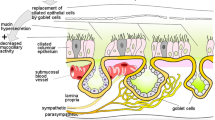Abstract
We studied serial changes of nasal airway resistance (NAR) and secretory response after topical stimulation with either capsaicin or histamine, since both are known to stimulate a chemosensitive sensory C-fiber ending. After topical capsaicin stimulation, a dose-related increase of NAR was noted, with a peak response occurring at 10–20 min. These NAR responses were completely abolished following systemic pretreatment with capsaicin. However, they were not affected by atropine, diphenhydramine or hexamethonium pretreatment. After topical histamine stimulation, an atropine-resistant increase of NAR was found and continued more than 120 min. The early phase of this response was significantly suppressed by the systemic pretreatment with capsaicin. A secretory response also occurred after topical capsaicin stimulation and continued for 30 min. This secretory response was almost completely blocked by atropine, hexamethonium or systemic capsaicin pretreatment and was partially suppressed by diphenhydramine pretreatment. These findings suggest that sensory C-fiber stimulation can induce both atropine-resistant vascular reflexes and atropine-sensitive secretory reflexes, and that these reflexes might play an important role during the early phase after nasal stimulation.
Similar content being viewed by others
References
Asakura K, Narita S, Kojima T, Kataura A (1992) Study on the dye leakage response of nasal mucosa following topical capsaicin challenge in guinea pig. Acta Otolaryngol (Stockh) 112:545–551
Davis B, Roberts AM, Coleridge HM, Coleridge JCG (1982) Reflex tracheal gland secretion evoked by stimulation of bronchial C-fibers in dogs. J Appl Physiol 53:985–991
Foreman JC, Jordan CC, Oehem P, Renner H (1983) Structure activity relationships for some substance P-related peptides that cause wheal and flare reactions in human skin. J Physiol (Lond) 335:449–465
Jessel TM, Iversen LL, Cuello AC (1978) Capsaicin-induced depletion of substance P from primary sensory neurons. Brain Res 152:183–188
Konno A, Togawa K, Fujiwara T (1983) The mechanisms involved in onset of allergic manifestations in the nose. Eur J Respir Dis 64 [Suppl 128]: 155–166
Lundblad L, Anggard A, Lundberg JM (1983) Effects of antidromic trigeminal nerve stimulation in relation to parasympathetic vasodilation in cat nasal mucosa. Acta Physiol Scand 119:7
Lundblad L, Lundberg JM, Brodin E, Änggard A (1983) Origin and distribution of capsaicin-sensitive substance P-immunoreactive nerves in the nasal mucosa. Acta Otolaryngol (Stockh) 96:485–493
Lundblad L, Saria A, Lundberg JM, Änggard A (1983) Increased vascular permeability in rat nasal mucosa induced by substance P and stimulation of capsaicin-sensitive trigeminal neurons. Acta Otolaryngol (Stockh) 96:479–484
Lundblad L, Brodin E, Lundberg JM, Anggard A (1985) Effects of nasal capsaicin pretreatment and cryosurgery on sneezing reflexes, neurogenic plasma extravasation, sensory and sympathetic neurons. Acta Otolaryngol (Stockh) 100: 117–127
Marabini S, Ciabatti PG, Polli G, Fusco BM, Geppetti P (1991) Beneficial effects of intranasal applications of capsaicin in patients with vasomotor rhinitis. Eur Arch Otorhinolaryngol 248: 191–194
Matsuda H, Kawakita K, Kiso Y, Nakano T, Kitamura Y (1989) Substance P induces granulocyte infiltration through degranulation of mast cells. J Immunol 142:927–931
Meed J (1960) Control of respiratory frequency. J Appl Physiol 15:325–336
Narita S, Asakura K, Kataura A (1992) The effects of anti-PAF agent and anti-allergic drug on experimental allergic rhinitis in guinea pigs. J Otolaryngol Jpn 95:1190–1197
Saria A, Gamse R, Peterman J, Fisher LA, Theodorsson-Norheim A, Lundberg JM (1986) Simultaneous release of several tachykinins and calcitonin gene-related peptide from rat spinal cord slice. Neurosci Lett 63:310–314
Shirasaki H, Kojima T, Asakura K, Simamoto K, Iimura O (1989) The pathophysiological role of kinin and chemical mediators on experimental allergic rhinitis. Kinin V, part A. Plenum, New York, pp 375–378
Stjarne P, Lundblad L, Lundberg JM, Änggard A (1989) Capsaicin and nicotine-sensitive afferent neurones and nasal secretion in healthy volunteers and in patients with vasomotor rhinitis. Br J Pharmacol 96:693–701
Author information
Authors and Affiliations
Rights and permissions
About this article
Cite this article
Asakura, K., Narita, S., Kojima, T. et al. Changes in nasal airway resistance and secretory response in the guinea pig after nasal challenge with capsaicin and histamine. Eur Arch Otorhinolaryngol 251, 224–228 (1994). https://doi.org/10.1007/BF00628428
Received:
Accepted:
Issue Date:
DOI: https://doi.org/10.1007/BF00628428




